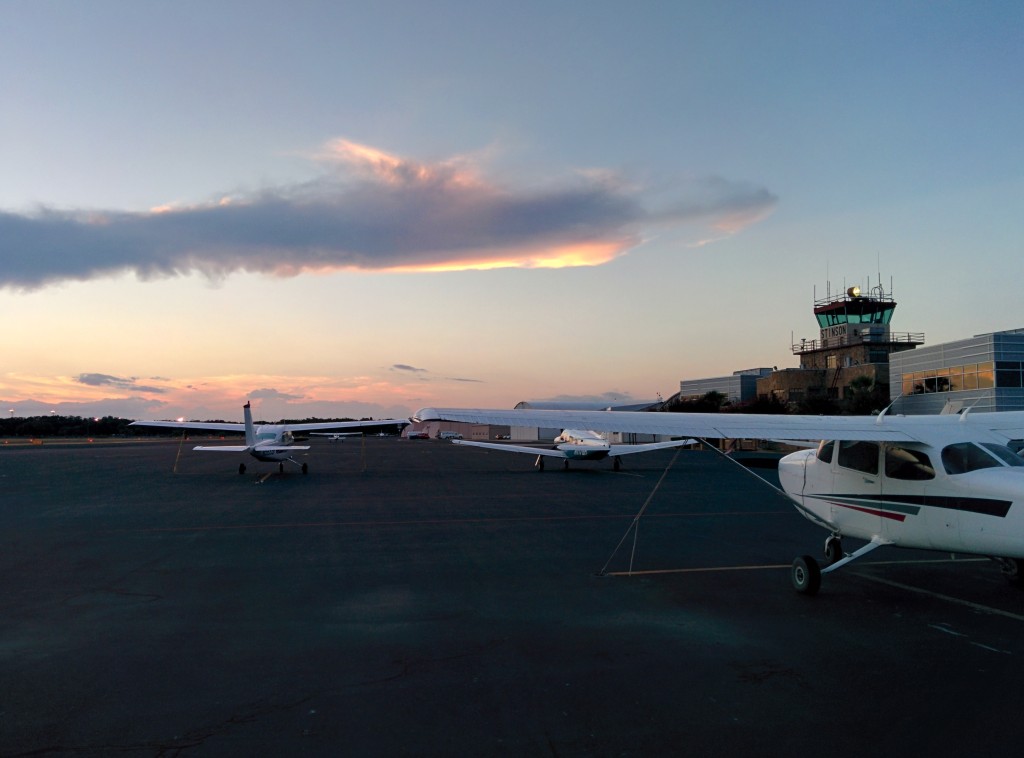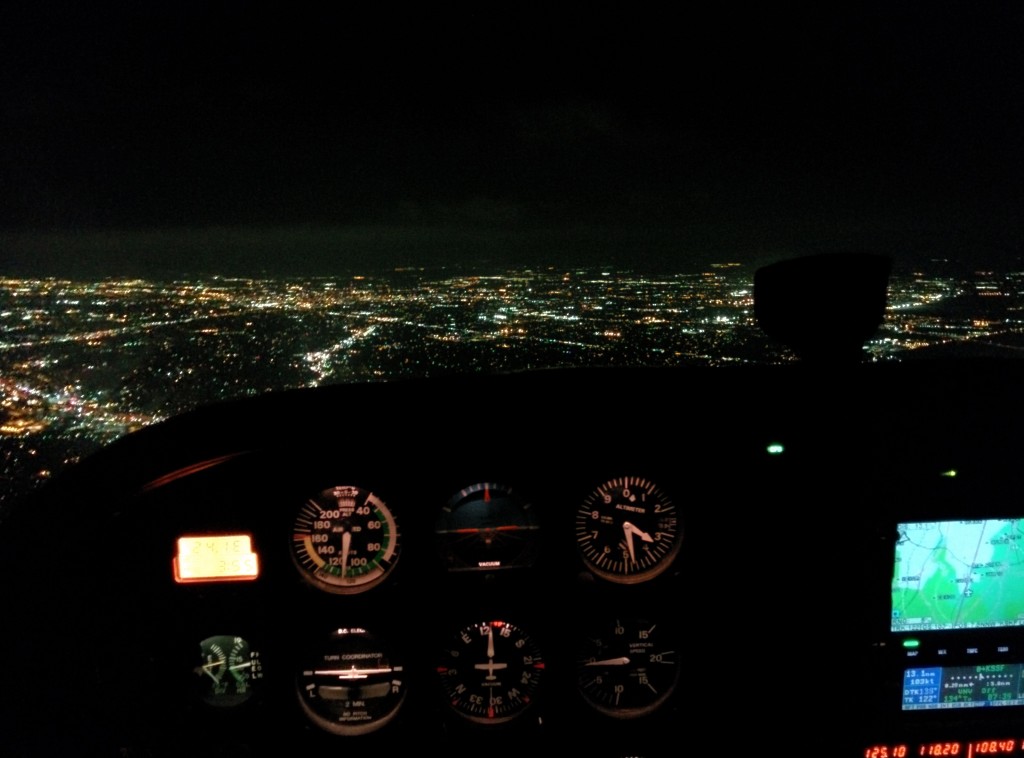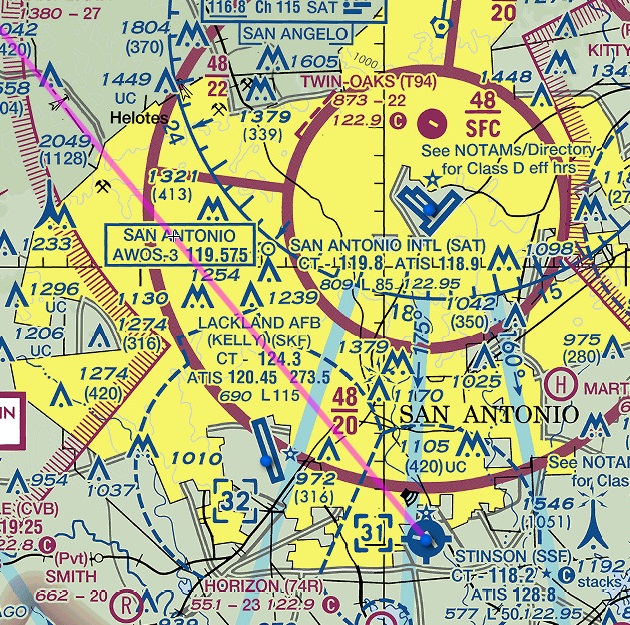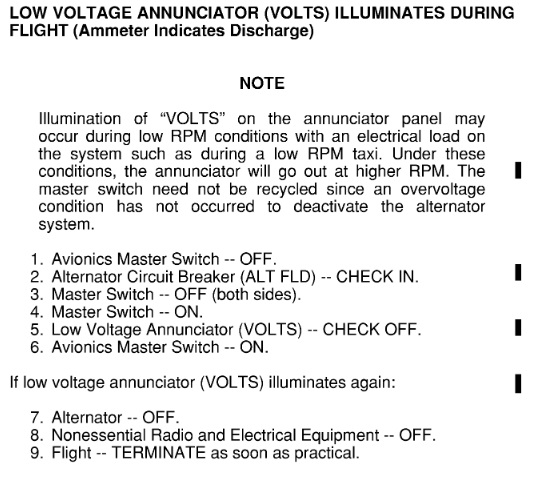Mechanical failures in flight are something that is taught from day one during primary flight training, but rarely do students get an opportunity to experience the real thing firsthand. I’ve seen some videos where that wasn’t the case, especially one student pilot who landed on a golf course after an engine failure, but for the majority of pilots the closest they come to an in-flight emergency in training is when the instructor abruptly cuts the throttle and won’t give it back. Lucky for me, I found myself with a playful little mechanical failure during the night cross country of my training . . .
As part of the requirements for taking the practical exam for my private pilot’s certificate, I needed to accumulate a few hours flying while at night. From the FAR §61.109:
(a) For an airplane single-engine rating. Except as provided in paragraph (k) of this section, a person who applies for a private pilot certificate with an airplane category and single-engine class rating must log at least 40 hours of flight time that includes at least 20 hours of flight training from an authorized instructor and 10 hours of solo flight training in the areas of operation listed in § 61.107(b)(1) of this part, and the training must include at least—
[…]
(2) Except as provided in § 61.110 of this part, 3 hours of night flight training in a single-engine airplane that includes—
(i) One cross-country flight of over 100 nautical miles total distance; and
(ii) 10 takeoffs and 10 landings to a full stop (with each landing involving a flight in the traffic pattern) at an airport.
Honestly, flying at night was some of the most fun I had during my training. The air is a lot smoother while at night, and it was definitely a lot cooler — especially in the middle of the hot Texas summer. I had been used to coming back from flights with my shirt drenched in sweat, so having a nice cool night flight instead was a welcome change of pace. Above all though, the world just looks so beautiful at night.
For the first night flight, I hopped in the 172 with my CFI and flew out to New Braunfels, did one landing, then came back to Stinson for two more before the tower closed. We didn’t realize that New Braunfels didn’t have any approach path lighting, which led to my first “black hole” approach and led me to write an article about the experience late last year. Needless to say we weren’t looking to stretch our luck with more landings at New Braunfels (as planned), hence the quick return to Stinson.
It was a great introduction to night flying, but we still needed a cross country flight as well as a few more landings to meet the requirements. So the next week we decided to take the 172 up again and this time polish off the cross country requirement as well as the night landings.
The flight plan for the night would end up being the first leg of my long solo cross country flight, a simple straight shot up 281 and then following I-10 out to Kerrville (KERV), using Boerne Stage (5C1) as the intermediate checkpoint. Kerrville is a wonderful two-runway airport bristling with lights and a PAPI so I can avoid the same “black hole approach” sensation I felt at New Braunfels. We had planned on leaving Stinson just after the legal definition of night kicked in, spending about 30 to 45 minutes in the pattern at Kerrville, and then heading home.
METAR KSAT 290051Z 11010KT 10SM FEW060 FEW250 31/21 A2985 RMK AO2 SLP087 TCU DSNT W T03060211
The forecast called for a perfect night — scattered clouds well above us, a nice cool temperature, and relatively light winds aligned pretty much with the runway. As the sun was setting we strapped ourselves into the 172, programmed our flight plan into the KLN 94 GPS, and set off from Stinson into the night.
For the first part of the flight, things were very uneventful. We followed the little magenta line to our destination, entered the pattern, and successfully landed. At this point in my flying career I was starting to get the hang of that whole landing thing, occasionally greasing a landing but more often than not I was still putting the plane on the ground a little too hard.
Around the sixth landing, I screwed up. I slammed the airplane down on the runway hard enough that I was certain I had bent something. My flight instructor was not concerned in any way — apparently that wasn’t the worst landing he had seen in this airplane, and he was certain that everything was still A-OK. Nevertheless once we were safely off the runway I stopped the airplane and got out to personally inspect the undercarriage and fuselage. Using my handy Surefire flashlight I inspected the plane as best I could, and there didn’t appear to be anything amiss (no cracks or scrapes in the skin, tires still looked pristine, and the landing gear struts looked like they always do) so we continued the flight.
Rather than making all of the remaining required landings, we decided to head back to Stinson and finish off the full 10 there. It was getting late, and the idea was that the closer we were to home the happier we’d be. So we got back in the air, and set course for home.
Instead of heading all the way to 5C1 before turning we decided to head straight home, which was a couple minutes quicker. We started out at 3,500 feet, but after picking up the new weather report we decided that it was a better idea to drop about 500 feet just to be safe.
METAR KSAT 290351Z 12012KT 10SM SCT035 SCT250 28/22 A2991 RMK AO2 SLP107 T02830222
As we were starting to cross over San Antonio proper I snapped the above picture. The city was absolutely beautiful from the air at night, and with the smooth night air the ride was comfortable as could be. Just a few minutes later things started to go wrong.
The first indication of a problem was an intermittent flickering of the “VOLTS” indicator on the annunciator panel. It would flicker for a second, then go off for a minute or so before coming back on. I hit the “TEST” button on the panel to see if there might be a problem with the panel itself, but everything seemed to be working OK and all the indicators lit up without an issue. I checked the ammeter and the rest of the engine instruments, but everything seemed to be in order. I mentioned the flickering to the CFI and he didn’t seem to be too concerned.
I started thinking about what a failed alternator would mean for the flight.
There’s a battery in the airplane to supply power when the engine isn’t running, but I had no idea how old it was or what its condition would be. A fresh fully charged battery could power the plane for about 30 minutes, but I figured that 10 would be a better estimate. I could probably stretch that a bit by turning off unnecessary equipment, like the massive and ancient GPS display that was undoubtedly sucking up more amps than anything else in the plane.
If the battery and alternator did fail, the plane would still fly. The 172SP we were flying was a fuel injected version of the trusty old 172, but that system is run off a direct engine driven pump that is independent of the electrical system. In theory I could flip the master switch off and continue flying indefinitely in the airplane, although this might run me afoul of 91.205.
Losing power would definitely be an emergency situation, but not necessarily fatal. I would lose lights, transponder, and radios, but most of my instruments would stay online. The entire pitot static system would remain unaffected, so the airspeed indicator would keep working along with the altimeter and the VSI. Most of the gyros are vacuum driven, which is a separate system from the electrics and driven directly from the engine as well, meaning the artificial horizon and heading indicator would be OK. The only instrument I would lose is the turn / slip indicator, which in the grand scheme of things isn’t that bad.
The most important thing I would lose: flaps. The flaps on this 172SP are electrically driven, meaning that they won’t work without the master switch on and power available. Landing without flaps is possible, but not advisable and definitely not within my expertise at that time. If the power failed, I would be handing it over to the CFI to put us down on the ground for sure.
After thinking about what I would lose, I thought about where I could get help.
Stinson airfield was the destination of our flight, but the tower closed at 10 PM and the controllers had gone home already. The lights were on, but literally no one was home. We could land safely there, but if something went wrong we wouldn’t be able to call for help. And since the tower was closed and the airport had reverted to the “wild west” untowered airport rules, our lack of external lighting would make it impossible for anyone else in the pattern to see us coming in. It would be pretty dangerous.
The best option for help would be San Antonio International (KSAT). The airport was continuously operated throughout the night, and not only had an operating tower but emergency services right there on the field. And, best of all, the airspace was still Class C meaning we wouldn’t run into anyone. In theory, at least.
Worst case scenario, Lackland Air Force Base was still a possibility. It too had facilities, but flying unannounced into a military base (possibly with no radios) seems like a very good way to get shot down.
Five minutes later, the warning was more frequent. Ten minutes later and the alternator failed completely.
A quick look at the ammeter showed that we were definitely discharging — the alternator was no longer providing power to the system. We were completely on battery power at that point, and might have had 10 to 15 minutes to put the plane on the ground before the battery gave out.
After re-considering my options, I decided that the best curse of action was to land at Stinson. San Antonio International was a tempting option, but at that point in the flight we were basically on an extended final for runway 14 at Stinson. Turning back to San Antonio International would have actually taken longer to get on the ground compared to the quick and easy descent into Stinson — a very familiar airport to boot.
The last decision was about declaring an emergency. I had already made my decision to continue to Stinson (the closest airport at that point, albeit without any emergency services or tower) and I considered what declaring an emergency would get me. I didn’t need priority handling, since I was the only one in the pattern according to San Antonio Approach. I didn’t need emergency services at that point, since everything was still functioning and I still had time on the clock. And I didn’t need assistance finding the airport, since the runway lights were in sight and the PAPI showed us established on the glideslope. I decided that it would be more trouble than it was worth, signed off with San Antonio Approach, and started making my calls on the (now) Stinson CTAF.
Five minutes later we were on the ground and shut down at Stinson, having never lost power our entire approach and landing. The alternator was still inoperative, but it didn’t matter anymore. We shut down the plane, debriefed inside the FBO, wrote a love note to the mechanics, and went home.
In retrospect, there was one very important thing we overlooked: the emergency procedure checklist. The POH describes an emergency procedure for trying to get the alternator working again, which honestly I wasn’t aware of at the time. My only experience with emergency checklists were the usual engine failure and cabin fire checklists, but we never went over some of the more mundane ones (like this). Following this flight I made sure to familiarize myself with all of the checklists for the Cessna 172, something I probably should have done first.
In my defense, by the time the alternator properly failed we were pretty much on final for the runway at Stinson. We figured that we had more than enough time to land before the battery died, so that problem was secondary in our minds. What’s the old adage? “Aviate, navigate, communicate?” Well, we were a little busy aviating to look for a checklist we didn’t know existed for a problem that we thought wouldn’t concern us until well after landing.
Even if we had found the checklist, turning off the master switch on short final probably isn’t the best idea. For a few minutes everything was working fine and we were within visual sight of the airport, which is definitely a much different position than if we were at 6,500 feet 20 miles from the nearest airstrip. Trying to problem solve the issue might have been more distracting than beneficial at that point, and distractions in the cockpit have been known to be deadly.
We did do one thing right — we landed ASAP. The next week we went back out (in a different airplane) and finished off the required landings.
Things I learned:
- Read over the emergency checklists, and have them handy. All of them.
- Flaps in the 172SP are electric, and won’t work without power.
- Even if the CFI isn’t concerned, always be thinking “what if?”.



